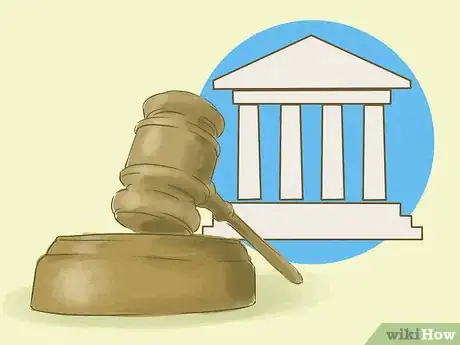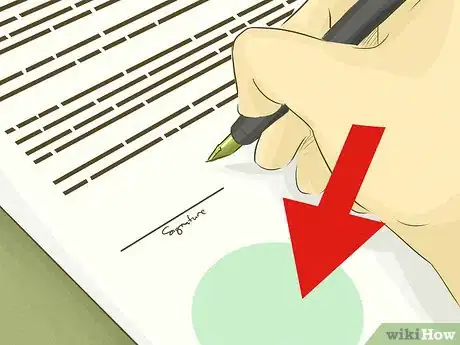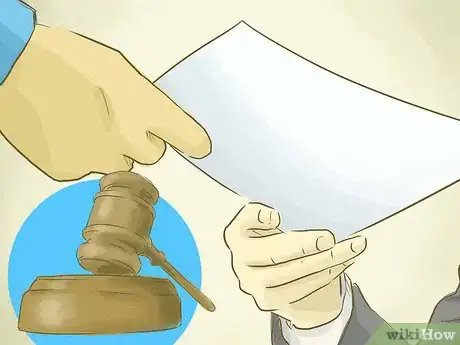This article was co-authored by Clinton M. Sandvick, JD, PhD. Clinton M. Sandvick worked as a civil litigator in California for over 7 years. He received his JD from the University of Wisconsin-Madison in 1998 and his PhD in American History from the University of Oregon in 2013.
This article has been viewed 199,135 times.
Couples who are unsure if they wish to remain married might consider a legal separation. A legal separation allows the parties to live apart, divide their debts and assets, and establish custody and support while remaining married.[1] The major reason for seeking a legal separation is to protect you from becoming liable for your spouse’s future debts. However, you remain legally married and unable to marry another. If you live in New York and want to file for a legal separation, you can pursue one of two avenues: filing a Separation Agreement or filing a Summons to your spouse and a Complaint for Judgment of Separation with the court.
Steps
Filing a Separation Agreement
-
1Understand a Separation Agreement. If the you and your spouse are agreeable to the terms and conditions of your separation, you can voluntarily enter into a formal separation agreement in writing that you can file with the court (“Separation Agreement”) and obtain an Order for Separation. A Separation Agreement and Order for Separation on file with the court will ensure that the terms and conditions agreed to between you and your spouse are enforceable against each other in the future.[2]
-
2Determine if you can legally separate in New York. New York has residency requirements governing Separation Agreements in the state. To become legally separated in New York, the following requirements must be met:
- The couple was married in the state, either spouse is a New York resident when the action is filed, and has been residing in the state for at least one year before filing;
- The parties have resided in New York as husband and wife and either party is a New York resident when the action is commenced and has been a resident for at least one year before filing;
- The grounds occurred in the state and either party has been a New York resident for at least one year before filing; or
- Either party has been a New York resident for at least two years prior to filing the action.
Advertisement -
3Choose the proper court. This is typically the court with jurisdiction over the county in which both parties live and/or agree to mutually. If you and your spouse live in different counties, the most convenient forum (or one that can be agreed to by both parties) is the most prudent selection.[3]
-
4Prepare the Separation Agreement. There are no forms available for a Separation Agreement. Such agreements are typically drafted in the same manner as any contract between parties.[4] The Separation Agreement becomes legally binding when signed by both parties and notarized. It can be enforced if the terms are violated by the other spouse.
- Be clear and concise when providing information. For example, instead of writing, “Respondent will have visitation on weekends,” you may want to write, “Respondent shall have visitation with the parties’ minor children every other weekend from 6 p.m. Friday to 6 p.m. Sunday.”
- If you want, you can find a document preparation service online. Online preparation service providers allow you to have your legal documents prepared without ever having to leave your home.
- If you wish, you may file it with the County Clerk's Office in the county where either of you currently live. There is typically a filing fee of $5.00.
- A Separation Agreement can’t be back dated to take into consideration the time you were separated before signing the agreement.
- You can find sample Separation Agreements online such as at: http://family.findlaw.com/divorce/sample-separation-agreement.html
-
5Finalize and file your legal paperwork. Review the final Separation Agreement agreed with your spouse. Both you and your spouse should sign the Separation Agreement before a notary. Personally deliver the original Separation Agreement and two copies to the Clerk of Court, file the original Separation Agreement, pay the $5.00 filing fee, and retain the two certified copies—one for you and one for your spouse.
- Your bank or a local fingerprinting service will both have notaries on staff.
-
6File for divorce. One year after signing and notarizing the Separation Agreement, you or your spouse may file for a divorce based on your Separation Agreement. This is called a “conversion” divorce.[5] Using this method, no grounds based on default or legal reasons to grant a divorce are necessary.[6] At the time you petition for your divorce proceeding in court:
- The court will credit the $5.00 fee paid to file the Separation Agreement toward the divorce filing fees. However, this is only if you file in the same county where you filed your Separation Agreement.
- You must attach a copy of the Separation Agreement to the complaint you file to initiate your divorce proceeding. This is only true if you did not ever file the Separation Agreement with the court.
- You can ask the court to include or incorporate some or all of the terms of your Separation Agreement into the divorce judgment. Incorporation of such terms in the petition for divorce usually makes it easier to finalize and enforce the terms of your divorce later. However, the judge may require that the Separation Agreement have specific wording, and yours may not be what that particular judge desires in his/her judgment.
Filing a Summons and Complaint for Judgment of Separation
-
1Understand a Summons and Complaint for Judgment of Separation. If you and your spouse cannot reach a Separation Agreement, you can ask the NY Supreme Court for a Judgment of Separation (“Judgment of Separation”) by filing a complaint for divorce and issuing a summons upon your spouse to appear in court (“Complaint” and “Summons”). When you file the Summons and Complaint with the court, you are asking the court to decide upon the terms and conditions of your separation and for the judge to enter his/her Judgment of Separation.[7] A judge may grant a Judgment of Separation on any one of the five following grounds for fault of your spouse:[8]
- Cruel and inhuman treatment by defendant that endangers the physical or mental well-being of the complaining spouse to such an extent that it would be unsafe or improper for the spouses to live together
- Abandonment of the complaining spouse by the other spouse without cause or consent
- Neglect or refusal to provide for the support of the complaining spouse where the defending spouse is responsible for such support under the Family Court Act
- Adultery within five years of starting the lawsuit for a Judgment of Separation. Adultery must be without the consent of the complaining spouse
- Confinement of the defending spouse in prison for three or more consecutive years after the marriage began
-
2Determine if you can legally separate in New York. New York has residency requirements governing Separation Agreements in the state. To become legally separated in New York, the following requirements must be met:
- The couple was married in the state, either spouse is a New York resident when the action is filed, and has been residing in the state for at least one year before filing;
- The parties have resided in New York as husband and wife and either party is a New York resident when the action is commenced and has been a resident for at least one year before filing;
- The grounds occurred in the state and either party has been a New York resident for at least one year before filing; or
- Either party has been a New York resident for at least two years prior to filing the action.
-
3Choose the proper court. A New York State Supreme Court is the only type of court that handles divorce cases, and a Supreme Court Judge is the only person who can legally grant a divorce. The county in which your spouse lives is the most common sense choice for filing your petition. If your spouse lives outside the jurisdiction of the court in which you decide to file your petition, he/she can subject the petition to a challenge on jurisdictional grounds.
- If you lose a jurisdictional challenge, you must start the entire process over.
-
4Obtain the proper forms. You must file several forms with the Clerk of Court to begin the proceedings. You can obtain the appropriate forms by either:
- Personally visiting your county clerk of court’s office and purchasing a forms packet to type up, sign, copy, and file.
- Visiting NYCourts.gov to locate and retrieve the forms online. You will find both PDF- and Word-formatted forms that you can print and complete. Specific instructions for each form will appear along with it. Forms for Summons and Verified Complaint may be accessed at http://www.nycourts.gov/divorce/divorce_withchildrenunder21.shtml#ucdforms with additional instructions for completion found here.
- You can also prepare a Complaint for Separation and Summons by using the forms for a Complaint for Divorce and Summons as well. Simply replace all references to the word ‘divorce’ with the words ‘legal separation’ in the Summons (UD-1a), Verified Complaint (UD-2), and Affidavit of Service (UD-3) documents.
-
5Prepare your legal paperwork. It may be prudent to seek assistance from an attorney to help you prepare and file your Summons and Verified Complaint. You can also seek help online at: http://www.nycourts.gov/courthelp/ and at the do it yourself site available at: http://www.nycourts.gov/courthelp/diy/index.shtml.
- The complaint must include the full names and birthdates of you, your spouse and all minor children of the marriage; the dates of marriage and separation; the ground(s) for the separation; a statement regarding residency; and a brief description of what you are asking the court to grant you in the Judgment of Separation.
-
6Sign the Verified Complaint before a notary public.[9] Area banks and fingerprinting services are two easy locations to find a notary public. You can also easily look them up online for your region.
-
7Deliver copies to the Clerk of Court. Personally deliver the one original and two copies of the Summons and Verified Complaint to the Clerk of Court for filing.[10] After the clerk stamps everything “Filed,” you will retain the two certified copies—one for you and one to be personally served on your spouse. The clerk will also issue a receipt, which the applicant will need to show when proceeding to court.
-
8Pay the filing fee. The court fee to obtain a court index number is $210.00 payable by cash, certified check (payable to the County Clerk), U.S. Postal money order, VISA, Mastercard, or American Express.[11]
- Put the index number and the date of the filing on the two certified copies of the Summons and Verified Complaint. A clerk may also do this for you when you file the papers.
-
9Have the Summons and Verified Complaint served on your spouse. Personal service of process on your spouse is the formal delivery of your court papers in order to officially notify him/her that he or she is a party in a lawsuit and that a response is required. You must have a third party serve both the Summons and Verified Complaint. If your spouse is personally served and does not respond to your court papers formally, he/she will waive his or her rights, and the court will grant your request for a Judgment of Separation by default. You can make the service of process as follows:[12]
- Personal Delivery - This entails using a third party service that specializes in delivering the papers within New York state to the person to be served.
- Substituted Service - This method requires two separate steps. First, you must deliver the process within New York state to a person of suitable age and discretion (who is willing to accept the papers) at the actual place of business, dwelling place, or usual place of abode of the defendant or respondent. Next, you must mail the papers by first class mail to the person to be served at his or her last known residence. You may also mail them to his or her actual place of business.
- You must mark the envelope used for the mailing “Personal and Confidential.” Also, you must not show in any way that the envelope contains papers about a legal action against the person being served.
-
10Have an Affidavit of Service prepared. The disinterested person who serves your spouse must prepare an Affidavit of Service (Form UD-3), which attests to the service of the Summons and Verified Complaint. You must submit this sworn, signed, and notarized Affidavit of Service (along with a copy of the Summons and Verified Complaint) when you visit the county clerk of court’s office to request they place your case on the court's calendar.
-
11Wait forty days. There is a 40-day waiting period from date of service to place the matter on the court's calendar.
-
12Appear for a hearing. You must appear in court for a hearing unless you and your spouse are able to reach an agreement that resolves all issues concerning the terms and conditions of separation. At the hearing, the judge will review evidence and listen to testimony before ruling on the contested issues. After the hearing, the judge will sign the Judgment of Separation decree and you will be legally separated.
-
13File for divorce. A Judgment of Separation can be converted into a divorce when certain steps are taken. To do so, the couple must:[13]
- Live separately and apart pursuant to the Judgment of Separation for one year or more
- Adhere to all the requirements of the Judgment of Separation for one year or more (specifically the party seeking divorce)
- File a Divorce Complaint with the Court seeking a Judgment of Divorce
- Because your Judgment of Separation will have been granted by the court based upon one of the same four “fault” grounds that are factors in deciding a divorce case, either spouse can file for a divorce based upon a “no fault” grounds one year after the date the Judgment of Separation was granted.
Warnings
- You should consult with an attorney before signing anything that may affect your legal or financial rights and obligations.⧼thumbs_response⧽
References
- ↑ http://www.nycbar.org/get-legal-help/article/family-law/judgement-separation/
- ↑ http://www.nycbar.org/get-legal-help/article/family-law/judgement-separation/
- ↑ http://www.nycbar.org/get-legal-help/article/family-law/judgement-separation/
- ↑ https://www.nycourts.gov/legacyPDFs/courts/6jd/forms/SRForms/legal_separationproced.pdf
- ↑ Domestic Relations Law §170[6]
- ↑ https://www.nycourts.gov/legacyPDFs/courts/6jd/forms/SRForms/legal_separationproced.pdf
- ↑ http://www.nycbar.org/get-legal-help/article/family-law/judgement-separation/
- ↑ http://www.nycbar.org/get-legal-help/article/family-law/judgement-separation/
- ↑ http://www.nycourts.gov/courthelp/diy/divorce.shtml
About This Article
Filing for separation is a good option if you want to live apart without getting a formal divorce. To file for separation in New York, you’ll need to draft a separation agreement and both sign it. This should include things like how you’ll share custody if you have children and who will live where. Once it’s signed, you’ll need to get it notarized and file it with your local court. If you and your spouse can’t agree on a separation agreement, you’ll probably want to hire an attorney. You'll also want to hire an attorney if your situation is complicated, like if cheating was involved or your spouse has been in prison. They can walk you through the judgment of separation process and divorce if you choose to go that route. To learn how to prepare for a hearing, read more from our Legal co-author.












































































